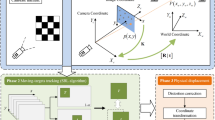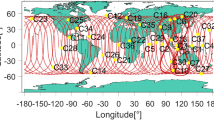Abstract
The threshold value used in receiver autonomous integrity monitoring algorithms to identify faults has a significant impact on positioning integrity and GPS/GNSS availability. The value is usually selected empirically or under certain distribution assumptions; its calculation for a non-Gaussian test statistic has not been solved. For fault detection methods using a particle filter, a new heuristic method is proposed to select an appropriate fault detection threshold value using an optimization model. In this method, a non-Gaussian cumulative log likelihood ratio (LLR) value is used as the test statistic. Its threshold is determined using an integrity risk minimization problem with an availability constraint. Since there is no closed form for this optimization model, a genetic algorithm with a local search strategy is adopted to find a near-optimal solution. Experimental results show that this method can be used to compute the non-Gaussian fault detection threshold value subject to different availability constraints. Comparisons with empirical and distribution-based methods indicate that while meeting the same probability for false-alert constraint, the probability of missed detection in the optimized approach is much lower than for other methods, especially for small numbers of errors. Since the cumulative LLR value does not exhibit obvious statistical features for any distribution, the performance of our optimized approach is stable for different test cases and satellite data sets.








Similar content being viewed by others
References
Ahn J, Rosihan Won DH, Lee YJ, Nam GW, Heo M-B, Sung S (2011) GPS integrity monitoring method using auxiliary nonlinear filters with log likelihood ratio test approach. J Electr Eng Technol 6:563–572. doi:10.5370/JEET.2011.6.4.563
Beyer HG, Deb K (2001) On self-adaptive features in real-parameter evolutionary algorithms. IEEE Trans Evol Comput 5:250–270. doi:10.1109/4235.930314
Bhatti UI, Ochieng WY, Feng S (2007a) Integrity of an integrated GPS/INS system in the presence of slowly growing errors. Part I: a critical review. GPS Solut 11:173–181. doi:10.1007/s10291-006-0048-2
Bhatti UI, Ochieng WY, Feng S (2007b) Integrity of an integrated GPS/INS system in the presence of slowly growing errors. Part II: analysis. GPS Solut 11:183–192. doi:10.1007/s10291-006-0049-1
Bhatti UI, Ochieng WY, Feng S (2012) Performance of rate detector algorithms for an integrated GPS/INS system in the presence of slowly growing error. GPS Solut 16:293–301. doi:10.1007/s10291-011-0231-y
Blanch J, Walter T, Enge P (2013) Results on the optimal detection statistic for integrity monitoring. In: Proceedings of ITM 2013, Institute of Navigation, San Diego, CA, January 28–30, pp 262–273
Brenner M (1995) Integrated GPS/inertial fault detection availability. In: Proceedings of ION GNSS 1995, Institute of Navigation, Palm Springs, CA, September 12–15, Pts 1 and 2
Deb K, Agarwal RB (1995) Simulated binary crossover for continuous search space. Complex Syst 9:115–148
Deb K, Pratap A, Agarwal S, Meyarivan T (2002) A fast and elitist multiobjective genetic algorithm: NSGA-II. IEEE Trans Evol Comput 6:182–197. doi:10.1109/4235.996017
Feng S, Ochieng W (2007) A difference test method for early detection of slowly growing errors in GNSS positioning. J Navig 60:427–442. doi:10.1017/s037346330700433x
Feng SJ, Ochieng WY, Walsh D, Ioannides R (2006) A measurement domain receiver autonomous integrity monitoring algorithm. GPS Solut 10:85–96. doi:10.1007/s10291-005-0010-8
Feng S, Ochieng W, Moore T, Hill C, Hide C (2009) Carrier phase-based integrity monitoring for high-accuracy positioning. GPS Solut 13:13–22. doi:10.1007/s10291-008-0093-0
Feng S, Jokinen A, Ochieng W, Milner C (2012a) Multi-constellation RAIM in the presence of multiple faults-a bottom up approach. In: Proceedings of ION GNSS 2012, Institute of Navigation, Nashville, TN, September 17–21, pp 2858–2867
Feng S et al (2012b) Integrity monitoring for carrier phase ambiguities. J Navig 65:41–58. doi:10.1017/s037346331100052x
Feng S, Jokinen A, Ochieng W, Liu J, Zeng Q (2014) Receiver autonomous integrity monitoring for fixed ambiguity precise point positioning. In: Sun J, Jiao W, Wu H, Lu M (eds) China satellite navigation conference, vol 304. Lecture Notes in Electrical Engineering, pp 159–169. doi:10.1007/978-3-642-54743-0_14
He P, Tan C, Huang H Research on receiver autonomous integrity monitoring algorithm using genetic algorithm resampling particle filter. In: Proceedings of 4th China satellite navigation conference, CSNC 2013, Wuhan, China, May 13–17. Lecture Notes in Electrical Engineering. Springer, pp 221–231. doi:10.1007/978-3-642-37404-3-20
Jokinen A, Feng S, Schuster W, Hide C, Moore T, Milner C (2012a) Improving fixed-ambiguity precise point positioning (PPP) convergence time and accuracy by using GLONASS. In: Proceedings of ION GNSS 2012, Institute of Navigation, Nashville, TN, September 17–21, pp 3708–3727
Jokinen A, Feng S, Ochieng W, Hide C, Morre T, Hill C (2012b) Fixed ambiguity precise point positioning (PPP) with FDE RAIM. In: 2012 IEEE/ION position location and navigation symposium (plans), pp 643–658
Juang J-C (2000) On GPS positioning and integrity monitoring. IEEE Trans Aerosp Electron Syst 36:327–336. doi:10.1109/7.826339
Kuo W, Wan R (2007) Recent advances in optimal reliability allocation. IEEE Trans Syst Man Cybern A Syst Hum 37:143–156. doi:10.1109/tsmca.2006.889476
Lee YC (1992) Receiver autonomous integrity monitoring (RAIM) capability for sole-means GPS navigation in the oceanic phase of flight. IEEE Aerosp Electr Syst Mag 7(5):29–36. doi:10.1109/62.257089
Li T, Wang J (2014) Analysis of the upper bounds for the integer ambiguity validation statistics. GPS Solut 18:85–94. doi:10.1007/s10291-013-0312-1
Lin F-H, Kuo W (2002) Reliability importance and invariant optimal allocation. J Heuristics 8:155–171. doi:10.1023/A:1017908523107
Milner C, Ochieng W, Schuster W, Porretta M, Curry C (2011) A regional space segment health monitor for local GPS integrity monitoring. J Navig 64:657–671. doi:10.1017/s0373463311000269
Misra P, Bayliss E, Lafrey R, Pratt M, Muchnik R (1993) Receiver autonomous integrity monitoring (RAIM) of GPS and GLONASS. Navigation 40(1):87–104
Ober PB New, generally applicable metrics for RAIM/AAIM integrity monitoring. In: Proceedings of ION GNSS 1996, Institute of Navigation, Kansas City, MO, September 17–20, pp 1677–1686
Raghuwanshi MM, Kakde OG (2004) Survey on multiobjective evolutionary and real coded genetic algorithms. In: Proceeding of the 8th Asia Pacific symposium on intelligent and evolutionary systems, pp 150–161
Schuster W, Bai J, Feng S, Ochieng W (2012) Integrity monitoring algorithms for airport surface movement. GPS Solut 16:65–75. doi:10.1007/s10291-011-0209-9
Srinivas M, Patnaik LM (1994) Adaptive probabilities of crossover and mutation in genetic algorithms. IEEE Trans Syst Man Cybern 24:656–667. doi:10.1109/21.286385
Toledo-Moreo R, Zamora-Izquierdo MA, Ubeda-Minarro B, Gomez-Skarmeta AF (2007) High-integrity IMM-EKF-based road vehicle navigation with low-cost GPS/SBAS/INS. IEEE Trans Intell Transp Syst 8:491–511. doi:10.1109/TITS.2007.902642
Verhagen S, Teunissen PJG (2006) New global navigation satellite system ambiguity resolution method compared to existing approaches. J Guid Control Dyn 29:981–991. doi:10.2514/1.15905
Wang E, Zhang S, Hu Q (2009) Research on GPS receiver autonomous integrity monitoring algorithm based on MCMC particle filtering. Chin J Sci Instrum 30:2208–2212
Xu X, Yang C, Liu R (2013) Review and prospect of GNSS receiver autonomous integrity monitoring. Acta Aeronaut Astronaut Sin 34:451–463. doi:10.7527/S1000-6893.2013.0081
Acknowledgments
This work is supported by the National Natural Science Foundation of China (Grant No. 61309005) and the doctoral West Light Foundation of the Chinese Academy of Sciences (2014). The authors would like to thank the anonymous reviewers for their valuable suggestions.
Author information
Authors and Affiliations
Corresponding author
Rights and permissions
About this article
Cite this article
He, P., Liu, G., Tan, C. et al. Nonlinear fault detection threshold optimization method for RAIM algorithm using a heuristic approach. GPS Solut 20, 863–875 (2016). https://doi.org/10.1007/s10291-015-0494-9
Received:
Accepted:
Published:
Issue Date:
DOI: https://doi.org/10.1007/s10291-015-0494-9




